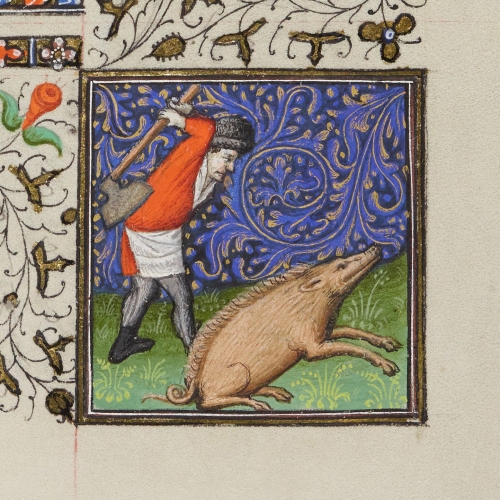
Last month we looked at pannage, feeding pigs on the autumnal fodder in wooded pastures, particularly on acorns. December, however, is less auspicious for our porcine friends. Vegetarians and vegans should look away now because after November’s pannage, December’s Labour of the Month is the slaughter of pigs.

It may seem odd to us that this was such a seasonal practice as we tend to have red meat available year round. However, agriculture and the food that people consumed in the middle ages were very closely tied with the cycle of the year. Over the winter months bacon grease replaced butter as the principal source of fat and pork when cured could provide the necessary protein to sustain tenant farmers until the spring when fresh food was more readily available. Additionally, adult pigs were not “overwintered” unless they were breeding stock since they quickly lost weight when food was scarce. Feeding the pigs on mast in November maximised how much food each animal would provide once they were slaughtered in December. “The cycle of swine fattening on acorns followed by slaughter was so important within the medieval agricultural cycle that it became the standard calendar depiction for either October/November or November/December.” (Jørgensen 2013) Actually, in MS B.11.22 (shown above) it is an ox or cattle that is for the chopping block, while MS B.11.4 has the slaughter of pigs as the labour for November, once again demonstrating the regional variation between the calendars in our manuscripts.

It was, of course, essential that peasants had plenty of provisions for the winter months, particularly in preparation for all that feasting by the fire in January and February. In fact, manuscript B.11.4, the 13th century English Psalter, seems to recommend that you get an early start on the feasting. One of the most famous December feasting traditions from the middle ages is the Boar’s Head Feast. While the slaughter of domestic pigs was the province of peasants, the hunting of wild boar was a decidedly elite pursuit and the serving of a Boar’s Head at noble tables is recalled in the 15th century Boar’s Head Carol, excerpted below:
The boar’s head, as I understand,
Is the rarest dish in all this land,
Which thus bedeck’d with a gay garland
Let us servire cantico.
Looking back over the past twelve months it is striking that, while the spring and summer months focused largely on agricultural activities, the calendars also featured pursuits of the wealth such as Maying and Feasting. Far from a utilitarian list of what essential tasks needed to be done in each month, along the lines of a modern Farmer’s Almanac, the medieval Labours of the Months cycle depicted agricultural work and other secular scenes as a way of showing how the material world responded to the divine ordering of things. Their context in Psalters and Books of Hours created for wealthy patrons reinforces the link between every day life and a religious understanding of the universe.

The final astrological sign in our twelve month cycle is Capricorn, the mythological “sea-goat” that is part mountain goat and part fish or sea serpent. The association between the stars that make up the constellation Capricornus and the sea-goat is one of the oldest consistent associations in astrology, dating back to the Middle Bronze Age. As one of the four cardinal signs of Classical astrology, the first day of Capricorn marks the Winter Solstice, the shortest day of the year in the Northern Hemisphere. However, due to the change in the position of the Earth’s rotational axis the sun now traverses Sagittarius on the Winter Solstice.
And so we come to the end of the cycle of the year and begin anew, accompanied by the resounding clatter of our old 2015 wall calendars landing in the bin. To see the medieval calendars we have featured throughout the year in the context of their full manuscripts, please have a look at the James Catalogue of Western Manuscripts. We wish you a happy December and a joyous New Year!
Further Reading
Jørgensen (2013) “Pigs and Pollards: Medieval Insights for UK Wood Pasture Restoration“, Sustainability, 5, pp. 387-399.
Larkin (2009) “The Death of the Boar“, The Medieval Garden Enclosed: The Cloisters Museum and Garden.
